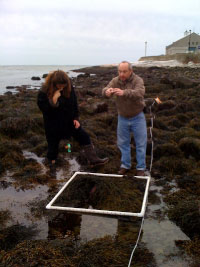|
|
 |
 |
 |
 |
COSEE-New England, originally based at the New England Aquarium in Boston, Massachusetts, convened the New England Ocean Science Education Collaborative (NEOSEC), a collaboration among more than 40 institutions from across the region, including museums and aquaria, universities, and research institutions. This collaborative has fostered synergy and effective partnerships that leveraged New England’s extraordinary assets to increase public understanding of the vital connections between people and the ocean.
 | NEOSEC member institutions learn the Census of Marine Life’s NaGISA
protocol at Project Oceanology |
To support NEOSEC, COSEE-New England and the New England Aquarium:
- Hosted periodic face-to-face meetings, where we developed joint goals for expanding ocean literacy beyond an individual institutions' reach, leveraging limited resources to make progress together.
- Convened a Governing Council, including representatives and alternates from every institutional member, for regular conference calls to monitor progress toward goals.
- Staffed subcommittees that also worked via conference calls to develop recommendations for the larger Council.
- Served as project manager and fiscal agent for joint fundraising efforts.
NEOSEC’s Governing Council operates through a consensus-driven, non-competitive model. This approach generates several valuable products and services, beyond the simple (but inspiring) opportunities to learn from each other. For example, NEOSEC:
- Hosts several internet-based tools, including a website, wikis, and the NEwswave blog where we share findings and products with a wider community.
- Produces a biennial Ocean Literacy Summit, which draws together a broad range of stakeholders to learn from each other about practical ways to apply the Ocean Literacy Principles. Proceedings from past Summits are available online.
- Designed a public campaign (Ocean7 Voyage of Discovery) to promote ocean literacy among visitors to our institutions, focusing first on a visually striking banner and a family-oriented portion of our website.
- Publishes a biweekly e-newsletter, NEwswave, with a subscriber list of more than 1100 educators, scientists, and facilitators around the region and the country.
NEOSEC successfully leverages the solid foundation provided by NSF funding to seek additional grant support. NOAA’s Informal Education Grant program recently awarded seven NEOSEC partners funding to carry out a three-year program incorporating up to 13 institutions serving summer campers 14 years old and up.NEOSEC’s strengths include:
- Connectivity. With a focus within New England and on ocean issues, we facilitate and support strong connections between scientists and educators. All committees include representatives from both sectors, and joint programs reflect both points of view.
- Inclusiveness. Support for joint projects comes from the broad membership. Members are invested in seeing joint efforts succeed.
- Diversity. Our member organizations bring a diversity of professional expertise, resources, geographic locale, and audiences together under a common mission, which in turn is complementary to individual members’ institutional missions.
- Cutting-edge networking. We employ robust and efficient tools for communication and networking, utilizing existing tools such as wiggio.com, blogging, and ning, while staying at the forefront of internet-based innovations, including explorations of Google Wave and the Wordpress MU platform.
- Open structure. We employ a non-hierarchical mode of networking, responsibility and decisionmaking that makes us flexible, nimble, and resourceful.
Member institutions have contributed to the whole in the following ways:
- Matching funds. In-kind funding for staff to contribute to joint efforts. As one example, to produce the 2008 Ocean Literacy Summit, ten institutions committed staff time for weekly planning conference calls, a total of 600 hours (approximately $24,000); the Maine Coastal Program contributed services and materials worth $4,000; and Boston University Marine Program defrayed the cost of our BU School of Management meeting space and food.
- Core network. Immediate connection with more than 500 staff in our member institutions.
Expansive audience. Collective membership and audience for potential outreach of more than 3 million people, including researchers, teachers, students, volunteers, and families across the U.S. and internationally.
- Institutional capacity. NEOSEC leverages institutional resources within the network to complement and supplement grant dollars. We share targeted audiences to enhance program participation, design expertise, and program evaluation assistance, to name a few.
In short, NSF’s grant funding has leveraged substantial additional resources from the New England ocean sciences education community – and we hope to continue to produce valuable partnerships and products for years to come.
Contributed by Pam DiBona
|
 |
 |
 |
 |
|
 |
|

